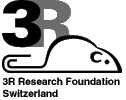
Renate Gay and Michel Neidhart
Department of Rheumatology, University Hospital Zürich, 8091 Zürich, Switzerland
renate.gay@usz.ch, michel.neidhart@usz.ch
Keywords: human; bone, cartilage; arthritis; inflammation; cell cultures: organ-specific; reduction
Duration: 1 year Project Completion: 1999
Background and Aim
Animals are currently used to study certain aspects of the development, pathology and therapy of rheumatoid arthritis (RA). Among the most commonly used animal models of arthritis are the antigen-induced models (adjuvant arthritis in rats, type II collagen-induced arthritis or streptococcal cell wall-induced arthritis in mice) and animal strains that spontaneously develop arthritis, e.g. MRL-lpr/lpr mice. In humans, RA is characterized by the presence of hyperplastic synovial tissue that invades cartilage and bone. A very recent experimental approach in vivo is to transplant human synovial tissue into immunodeficient SCID mice. Synovial tissue from patients with RA has been transplanted directly into the knee joints, subcutaneously together with human articular cartilage, or under the renal capsule. This approach results in cartilage invasion that resembles the progressive-destructive aspect of human RA. The aim of this project is to establish an in vitro model to investigate destructive processes in RA, to study the interaction between fibroblasts, macrophages and chondrocytes, and to evaluate strategies to inhibit joint destruction in RA.
Method and Results
Human and bovine chondrocytes cultured in sponges pre-treated with native bovine embryonic extracellular matrix (B-ECM) produced a cartilaginous matrix. Sulfur-35 (35S) was provided as a substrate for biosynthetic incorporation into proteoglycans. The 3-dimensional culture system was optimised for the number of chondrocytes (105 cells/sponge), the timing of 35S incorporation (day 21 after chondrocyte isolation), and medium (20% FCS). RA synovial fibroblasts (105 RA-SF) were added and the destruction of the matrix mediated by these RA-SF was monitored by the release of 35S. The system was modulated by the addition of cells from a human myelomonocytic cell line U937. RA-SF destroyed bovine cartilaginous matrix within 2 weeks (days 5-12) and human cartilaginous matrix within 3 weeks (days 10-18). ). Compared with the effect of RA-SF alone (948 ± 180 cpm/week), the addition of myelocytic U937 cells, IL-1 beta or TNF-alpha to the incubation medium increased the destruction of human cartilaginous matrix by 71% and 91% (1618 ± 204 and 1802 ± 307 cpm/week). We found that RA-SF expressing the CD44v4 isoform have a high destructive potential.
Conclusions and Relevance for 3R
This model is envisioned to study distinct aspects of human destructive joint disease under in vitro conditions and to replace and/or supplement animal experiments in basic research and drug testing. Animal models are still required in cases in which the bioavailability of the drug (absorption-distribution) is of concern. Based on the fact that pro-inflammatory cytokines enhance destruction it is concluded that in particular anti-IL-1 directed therapies may prevent cartilage destruction in RA.
References
1) Neidhart M., Gay R.E., Gay S. (2000) Anti-interleukin-1 and anti-CD44 interventions inhibit destruction in an in vitro model for cartilage invasion by synovial fibroblasts derived from patients with rheumatoid
arthritis. Arthritis Rheum. 43: 1719-28.
2) Pap T., van der Laan W.H., Aupperle K.R., Gay R.E., Verheijen J.H., Firestein G.S., Gay S., Neidhart M. (2000). Modulation of fibroblast-mediated cartilage degradation by articular chondrocytes in rheumatoid arthritis. Arthritis Rheum 43: 2531-6.
3) Neidhart M., Seemayer C.A., Hummel K., Michel B.A. Gay R.E., Gay S. (2003) Functional characterization of adherent synovial fluid cells in rheumatoid arthritis: destructive potential in vitro and in vivo. Arthritis Rheum 48 :1873-80.